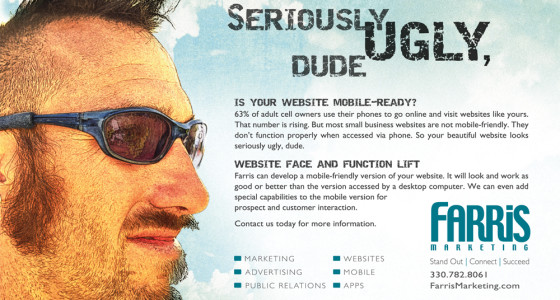Your business is not special. I’m sorry if that hurts your feelings, but it’s not. I don’t care how many people you employ, how long you’ve been in business or how many awards you’ve received from Rotary or your trade association.
Consider these facts: According to SBA.gov, there are 23 million small businesses in America. There are 851,961 small businesses in Ohio. There are 927,369 in Pennsylvania.
There are millions of non-profit organizations in America. There are millions of minority-owned businesses. Hundreds of thousands of “green” businesses, franchises, b2b, and home-based businesses. Tens of thousands of veteran-owned, online-only businesses, young entrepreneur-owned and 50+-owned.
I’m not saying what you do doesn’t matter. It does matter. But in the market place, you are not special. Forget the “every snowflake is different” baloney. You can pretty much bet there is an incredible amount of choices for prospects and customers looking for a product or service in your category.
So it really, REALLY matters how much effort you put into your marketing message. You need to make it as effective as possible. You want to stand out from the many other choices your prospects can easily select instead of your organization.
Here are my keys to a better marketing message:
1. A Great Opening Line Or Image
“On a winter’s day, just before Christmas in 1413, Nicholas Hook decided to commit murder.” That’s the opening line of a historical novel titled Agincourt by Bernard Cornell. How could you not continue reading a book that starts with that opening line?
Every book I read must have an opening line equally as gripping. That’s exactly what you must do with your marketing.
It doesn’t matter what medium is being used. For example, we produced TV spots for Meridian Community Care with the opening line “You have an addiction problem. In fact, we all do.” Print? The headline on one Farris print ad reads: “This is Gonna Hurt.” The photo is a vicious MMA-style fighter about to punch you.
Don’t expect the reader or viewer to wait until you get to “the good part.” You need to grab their attention and keep it.
2. Focus On What Matters
Don’t waste air time or space with catch phrases like “Please remember, tell a friend” that mean nothing. Consumers want what matters to them. That’s usually price and features, not platitudes. Tell them what problem you can solve — and how you solve it better, faster or cheaper.
3. Build A Better Response Vehicle
Remember all the choices that consumers have? If you get them to bite and check your website, why push them away with crummy and complicated forms, limited contact information and information that doesn’t match your advertisement?
If your ads or social media are sending prospects to your website, and they’re interested enough to go, you have 5-10 seconds to engage and connect with them. At my firm, when we build websites today, we try to include some device that will engage them and keep them engaged until they connect with the company or non-profit.
On a website for the Mahoning Valley Economic Development Corporation, we rebranded the loan services to the “GrowBiz Fund” and created a “Quick Loan Qualifier” to engage businesses and let them see how many types of loans they qualify for, as well as payment and other information.
We have similar devices going on many other types of websites. Once a prospect is interested, he or she qualifies themselves and submits the contact info. A connection is made, and soon thereafter a deal can be closed.
Use these three steps if you want to make a connection and succeed. Because in this world, you’re not special to anyone except your new customer.













Comment